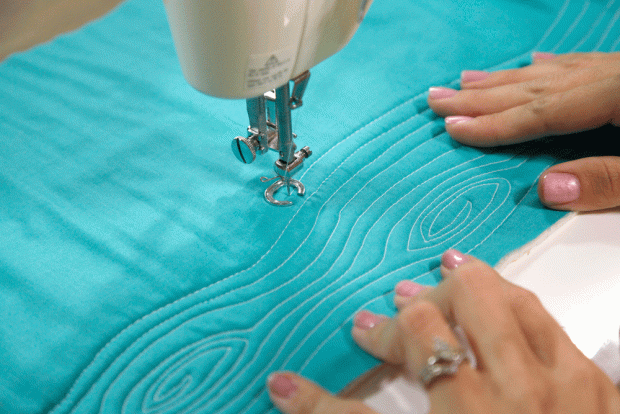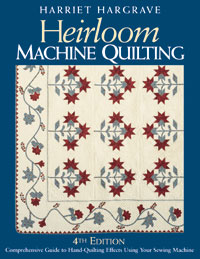I love to encourage others to try their hand at machine quilting. I’ve blogged about getting started with free-motion quilting here and some of my favorite FMQ tips here.
The number one tool I like my machine quilting students to acquire costs nothing, and everyone has one of these if they know where to look:
It’s a “can-do” attitude. 🙂
Before you feel like you need to jump in and quilt elegant feathers or spend a ton of time stitching intricately quilted designs, try these tricks instead for effective, quick results:
(1) Don’t underestimate the capabilities of your walking foot.
You can add amazing texture to your quilts with simple straight (or not-so straight) lines. I quilted Baby Bricks by marking a series of straight lines across the diagonal of the quilt and quilting them with a blending cotton thread.

Baby Bricks Quilt Along by Christa Watson
This was an effective way to quilt this quilt and it’s enough to hold the quilt together so that it’s washable and useable. However, I always like to add more quilting so I went back later and quilted many more rows in between the original lines. I didn’t mark any of the extra quilting. I simply used the edge of my walking foot as a guide.

(2) Try stitching “near” the ditch.
Stitching in the ditch is boring and time consuming, so I came up with a jazzier way to quickly quilt the seam lines while adding a little texture. Use a built-in decorative stitch with your walking foot and quilt across the seam lines so you can see it. Most machines will allow you to change the stitch length or width for a variety of options.
 This is such an easy way to quilt, even a child can do it! My daughter quilted her first quilt when she was just 8 years old. 🙂
This is such an easy way to quilt, even a child can do it! My daughter quilted her first quilt when she was just 8 years old. 🙂
(3) Try quilting gentle wavy lines with your free-motion foot and the feed dogs dropped.
For my Li’l Rascals quilt, I quilted an unmarked grid with a very thin blending thread. I started by quilting roughly parallel wavy lines all going the same way:
 I then turned the quilt and quilted perpendicular to my first set of lines to create an “improv” sort of grid. I love quilting textures that don’t have to be evenly spaced!
I then turned the quilt and quilted perpendicular to my first set of lines to create an “improv” sort of grid. I love quilting textures that don’t have to be evenly spaced!

(4) Practice quilting on real quilts.
The best way to learn is by actually quilting on a real quilt. Don’t stress too much about perfect tension or quilting designs. Try out your idea, dive in and do it, and then give the quilt away (to charity, or a family member or loved one). The recipient will love it and they will not notice your mistakes, I promise! It’s much easier to push past your mistakes when the quilt will not be around as a constant reminder of your learning.
(5) Remember: the best machine for quilting is the one you have right now.
My friend Lacey is stipple-quilting her very first quilt! I gave her two rules when I agreed to teach her how to quilt. #1 – She wasn’t allowed to use cheap fabrics. #2 She had to quilt her own quilt. 🙂

Lacey is working on her very first quilt. Whoo hoo!
Lacey doesn’t have all the fancy-schmancy equipment or a drop-in table with tons of room. She purchased a very basic, used Bernina from a local dealer and she doesn’t even own a walking foot. In fact, when quoted the price for a new walking foot, Lacey’s reply was, “for that amount of money, it should be called a running foot!” 🙂

Closeup of large stippling, also called “meandering.”
Lacey practiced on a couple of sample scraps to learn the rhythm of her machine, then she jumped right in and gave it a try on her actual quilt. She’s quilting on a larger scale, also known as meandering. She picked a bright pink thread that goes will all the colorful fabrics in the quilt. Doesn’t it look great so far?
(6) Give yourself permission to make mistakes.
The beauty of machine quilting is in the overall texture that quilting stitches add to the quilt. When you step back from your work a few feet, things look much better than when your nose is two inches away from your stitches. And when in doubt, add more quilting! The best way to hide imperfect stitches is with more imperfect stitches. 🙂
Think about it this way – if you are just beginning your journey into quilt-making, then your quilting skills will be at about the same level as your piecing skills. If you challenge yourself to quilt all of your quilts from the beginning, you can improve both techniques simultaneously, one quilt at a time!












































